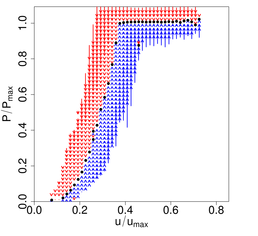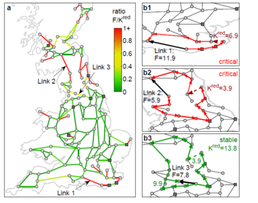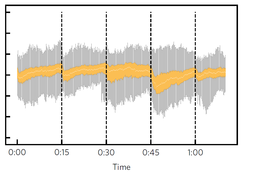Scientific Program
Scientific Program
Scientific Program

Stefan Harfst, University Oldenburg
Introduction to High-Performance Computing
Computer simulations have become an important tool for research in many scientific fields. In energy research, this includes fluid dynamical simluations of wind turbines and wind parks, the analysis and prediction of weather condition, and the modelling and optimization of energy networks. Often the computational cost for these simulation require the use of supercomputers. Additional challenges arise from the need to parallelize numerical algorithms and make them scale on upcoming exascale computers with an estimated 100 million compute cores.
In this lecture, an introduction to high-performance computing will be given. The typical hardware and architecture of supercomputers will be discussed using the supercomputer CARL at the University Oldenburg as an example. Running simulations on a high-performance compute cluster usually requires the use of a job scheduler and job scripts, an examples for this will be given. The introduction will close with an overview of parallel programming models.
In the practical parts, participants can try out the demonstrated examples by themselves and deepen their understanding of supercomputers. The basics of parallelization will be learned in an example.
Software Engineering for Scientists
Katja Biswas, Department of Physics and Astronomy, Texas A&M University, USA
Writing complex computer programs to study scientific problems requires careful planning and an in-depth knowledge of programming languages and tools, as well as analysis and visualization programs. In this lecture, the importance of using the right tool for the right problem is emphasized. Furthermore, the core concepts needed to work in a Linux/UNIX environment are presented. Common tools to organize computer programs (svn and make), as well as to debug (gdb, valgrind) and improve them (gprof, compiler flags) are discussed, followed by simple data reduction strategies and visualization tools. Finally, some scientific libraries such as Boost, GSL, LEDA and Numerical Recipes are outlined.
Random Number Generation
Katja Biswas, Department of Physics and Astronomy, Texas A&M University, USA
Random numbers play a crucial role in science and industry. Many numerical methods require the use of random numbers, in particular the Monte Carlo method. Therefore it is of paramount importance to have efficient random number generators. The differences, advantages and disadvantages of true and pseudo random number generators are discussed with an emphasis on the intrinsic details of modern and fast pseudo random number generators. Furthermore, standard tests to verify the quality of the random numbers produced by a given generator are outlined. Finally, standard scientific libraries with built-in generators are presented, as well as different approaches to generate non-uniform random numbers. Potential problems that one might encounter when using large parallel machines are discussed.

Alexey Chernov, Department of Mathematics, University Oldenburg
Numerical Methods for Diffusion Problems
Diffusion processes play a prominent role in many applications in science and engineering. In this lecture we review the key concepts of the finite element approximation for stationary diffusion problems in isotropic and anisotropic media. The theoretical part reviews the foundations of the finite element approach including its construction and accuracy. The practical part discusses the implementation of the finite element method in two space dimensions including the algorithmic realisation of particular steps and the composition of the data structures. In the complementary exercise class we will test and extend an existing MATLAB implementation of piecewise linear finite elements.

Katja Biswas, Department of Physics and Astronomy, Texas A&M University, USA
Introduction to Monte Carlo Methods
Monte Carlo methods play an important role in scientific computation, especially when problems have a vast phase space. In this lecture an introduction to the Monte Carlo method is given. Concepts such as Markov chains, detailed balance, critical slowing down, and ergodicity, as well as the Metropolis algorithm are explained. The Monte Carlo method is illustrated by numerically studying the critical behavior of the two-dimensional Ising ferromagnet using finite-size scaling methods. In addition, advanced Monte Carlo methods are described (e.g., the Wolff cluster algorithm and parallel tempering Monte Carlo) and illustrated with nontrivial models from the physics of glassy systems.


Lueder von Bremen, Institute of Networked Energy Systems, DLR and Forwind, University Oldenburg
Introduction to Numerical Weather Prediction and application to wind power forecasting
The early history of numerical weather prediction (NWP) and the development of electronic computers are closely tied with the undertaking of John von Neumann who recognized the enormous computational task involved in weather forecasting. Since then some of the most powerful computer are used by weather services.
In this lecture the basics of modern NWP and the concept of Ensemble Forecasting are given. Examples from short-term wind power forecasts will illustrate the importance of NWP for the management of power supply systems that are primarily based on Renewables Energies. Rigid verification of different variables of weather forecasts document that the skill of forecasts is slowly but continuously increasing over the past decades.
During the exercises the gained knowledge on forecast verification will be used to experience the handling of large-scale forecast data and to assess the skill scores for ensemble and deterministic forecasts.

Example of a Langevin Power Curve of a wind turbine, characterizing the deterministic dynamics of the machine. The drift function D(1)(P,u) of the power signal P is plotted against the wind speed u. Stable fixed points are presented as solid bullets, while arrows show the sign of D(1)(P,u), pointing towards the fixed points. These results were derived from a field measurement.
Stochastic Modeling for Renewable Energies
Renewable energies present a number of characteristic properties which differ significantly from conventional enery sources. Besides being, in principle, freely available and renewable, their distributed and fluctuating nature constitutes new challenges to a future renewable energy system.
In this lecture, we will give an introduction to stochastic and dynamic features of electrical feed-in generated by wind and solar energy. We will furthermore discuss to which degree wind speeds can be modeled by stochastic differential equations of the Langevin type. As a practical application we will introduce the conditional Langevin approach to derive a wind turbine's power characteristic in terms of stochastic dynamics. At the example of photovoltaic power we will hit the limits of the Langevin type stochastic differential equations, and extend the method to a jump-diffusion type equation. Moreover, we will discuss the derivation of parameters of the according jump process from measurement data.
In the practical parts, participants can derive the Langevin power curve of a wind turbine from available measurement data. Necessary data will be provided as well as parts of the necessary algorithms.
Energy Networks
Electric energy systems are among the largest interconnected networks on the planet. They exhibit certain traits unique to this critical infrastructure. In this lecture we will discuss existing structures and technical basis of energy system operation to generate, transfer and distribute electricity and their interaction and dependency on each other. We will learn about the fundamentals of power system modelling and solving the complex-valued power-flow equations. Focus will be on modern computational methods for power system operation under real-time constraints.

Power system modelling with time and data/information constraints.
Braess' Paradox, Anomalous Fluctuations and Nonlocal Rerouting in Power Grids

Analysis of network stability in case of individual link failure, see [3] for details.

Frequency fluctuations around the reference frequency, see [4] for details.
The collective dynamics of networks fundamentally underlies the function of a wide range of infrastructure systems around us, ranging from communication and traffic networks to power grids and other supply networks. Yet the collective network dynamics in general is far from fully understood today. In the lecture, I will provide a basic overview on collective dynamical phenomena and how to characterize them and offer an introduction to the challenges of the rapidly developing field of Network Dynamics.
I will present three phenomena that emerge across networked systems and that have particular relevance to power grids: (i) Braess' paradox in oscillatory systems, explaining how adding links may remove previously existing operating states through 'geometric frustration' [1], (ii) nonlocal flow rerouting [2,3], the finding that an infrastructure might be systemically relevant although local measures indicate the opposite; and iii) anomalous fluctuations [4] and their spreading [5], asking how local changes dynamically impact networks in a distributed yet often characteristic way.
Methods for the analysis, prediction, and control of network dynamics will be presented along with the phenomena. As a particular highlight, we will learn about the differential notion of 'network susceptibilities'[6] and explain how to exploit these to predict whether of not a link has the potential to cause Braess' paradox. We will discuss consequences of the presented findings for the design and operation of future-compliant power grids as well as the meaning of where, how much and in which sense modeling may contribute to those complex, agent-driven real world systems.
This is work with Debsankha Manik, Benjamin Schaefer, Dirk Witthaut, Xiaozhu Zhang and others.
References [1] D. Witthaut & M. Timme, New J. Phys. 14:083036 (2012) [2] C. Kirst et al., Nature Communications 7, 11061 (2016) [3] D. Witthaut et al., Phys. Rev. Lett. 116, 138701 (2016) [4] B. Schaefer et al., Nature Energy 3:116 (2018) [5] X. Zhang et al., Localization and Nonlocal Resonances in Fluctuation Driven Oscillator Networks and Power Grids, under revision (2018) [6] D. Manik et al., Predicting Braess' Paradox by Network Dipoles, in preparation (2018)
Meteorological wind field modelling with mesoscale and large-eddy simulation models
The most popular application of meteorological wind field modelling is certainly weather forecasting. But beyond that a main field of application is renewable energies, e.g. wind resource assessment for the planning of wind farms or forecasts of solar and wind power for the energy market and grid operators.
After a short introduction and motivation, the first part of the lecture will focus on mesoscale wind field modelling with the Weather and Research Forecasting (WRF) Model. The open-source WRF model is used and continuously developed by a large worldwide research community. It is designed for both operational weather forecasting applications as well as for research applications. The term “meso” means “not global”, i.e. simulation domains in the order of 100 - 5000 km and grid resolutions of a few kilometers. As an application example illustrating both the benefits and also the limitations of mesoscale simulations, the New European Wind Atlas project will be introduced.
The second part of the lecture will focus on large-eddy simulations (LES). In contrast to mesoscale simulations, in which atmospheric turbulence is not resolved but completely modelled, LES are able to resolve large turbulent motions (in the order of 1-1000 m) in the atmospheric boundary layer. Only the small scale turbulence has to be modelled. Typical model domains comprise a few kilometers and grid resolutions are in the order of a few meters. LES need huge computational resources, so they are mostly used for research purposes and (usually) not as an operational tool. However, as computers become more and more powerful, LES become increasingly interesting also from the industry’s perspective. In our group we use the open-source LES model PALM which we enhanced with a wind turbine model. This enables us to investigate how wind turbines and wind farms interact with the atmospheric boundary layer flow. The PALM wind turbine model will be presented and selected application examples will be shown.

Snapshot of a single wind turbine wake interacting with the atmospheric boundary layer. Shown is the normalized wind speed in hub height (90 m), simulated with the LES model PALM.


